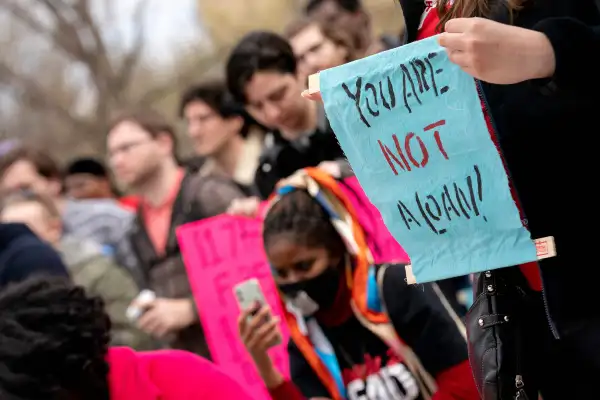Millions of Borrowers Just Got a Quicker Path to Student Loan Forgiveness

Changes announced by the Department of Education Tuesday will help millions more borrowers become eligible for student loan forgiveness under income-driven repayment plans.
The Education Department said it will conduct a one-time revision of payment counts that will result in immediate forgiveness for about 40,000 borrowers who are in the Public Service Loan Forgiveness (PSLF) program. After the changes, more than 3.6 million borrowers who are enrolled in income-driven repayment (IDR) plans will also get at least three years of credit to bring them closer to loan forgiveness.
“Student loans were never meant to be a life sentence, but it’s certainly felt that way for borrowers locked out of debt relief they’re eligible for,” Secretary of Education Miguel Cardona said in a release announcing the news.
The changes will address what the Cardona called “years of administrative failures.” Borrowers’ accounts will be automatically updated later this year, the department said.
Income-driven repayment plans, which have grown in popularity in the past decade, are meant to serve as a safety net for lower-income borrowers. There are four different income-driven plans borrowers can enroll in, each with slightly different eligibility and rules. But each one ties monthly payments to a borrower’s earnings and forgives any outstanding balance after 20 to 25 years.
Public Service Loan Forgiveness, which helps borrowers in often lower-paying public sector jobs, requires being in an income-driven repayment plan, but it speeds up the timeline to forgiveness — granting it in just 10 years.
But both IDR plans and PSLF have come under scrutiny in recent years for failing to live up to their promises.
An NPR investigation published earlier this month found systematic problems with how the repayment plans were administered, and a 2021 report from the National Consumer Law Center and the Student Borrower Protection Center found that out of millions of borrowers who’d been paying for two decades, just 32 had their loans forgiven.
Last week, senators called on the Consumer Financial Protection Bureau to investigate income-driven plans, while more than 100 advocacy organizations pushed the Biden administration to issue an “IDR waiver.” This would retroactively count all the months a borrower was in repayment as progress toward forgiveness, regardless of what plan they were in.
Most borrower advocates and financial aid experts applauded Tuesday’s announcement, while stressing that more improvements are needed.
“This is a small step toward rectifying the situation for borrowers who were misled or in the dark about all the options available to them,” Justin Draeger, CEO of the National Association of Student Financial Aid Administrators, said in a statement.
Meanwhile, three organizations representing student loan service companies, which manage the repayment process and are frequently blamed for its problems, called the one-time review "another quick fix, band-aid approach to complex programmatic issues.” The servicers also said they had no advance notice of the change, making it difficult for them to plan ahead for borrowers’ questions.
The actions announced Tuesday will affect borrowers who were placed by their services into long-term periods of forbearance when they could have been making payments under the income-driven plans.
The office of Federal Student Aid will conduct one-time account adjustments that will count forbearances of more than 12 consecutive months or more than 36 cumulative months as progress toward repayment.
If you were put into a shorter-term forbearance that doesn’t hit the 12- or 36-month threshold for an automatic revision, you can ask for an account review by filing a complaint with the FSA Ombudsman at Studentaid.gov/feedback.
The department is also conducting a one-time revision of payments to address flaws in how the department and its servicers had tracked — or rather, failed to track — payment counts.
If you have Direct loans or federally-managed Federal Family Education Loans, the department will count each month your loans were in "repayment" status as progress toward forgiveness under income-driven repayment, regardless of which plan you were enrolled in. If you made payments on your loans and then consolidated them into a single loan, your payments pre-consolidation will also be added to your payment count.
Any borrower who has made the required number of payments for IDR forgiveness based on this payment-count revision will receive loan cancellation automatically.
In other words, if you're in a plan that grants forgiveness after 20 years of payments, you'll have your loans automatically cancelled if the revisions put you at 240 monthly payments. If your plan requires 25 years, the required number of payments would be 300.
In addition to the 40,000 borrowers in the PSLF program who will get immediate forgiveness, the department estimates several thousand borrowers with older loans in income-driven plans will receive immediate forgiveness after these payment count revisions.
For most borrowers, though, the revisions will simply move them further along in their timeline to forgiveness — potentially making them free of student loan debt years ahead of schedule.
The process will start immediately, but borrowers may not see changes until the final months of 2022, the department said.
Moving forward, the Education Department says it will issue new guidance to student loan servicers to offer more accurate payment tracking, and in 2023, the Federal Student Aid office will begin displaying IDR payment counts on StudentAid.gov so borrowers can view their progress after logging into their accounts.
More from Money:
Millions of Borrowers Behind on Student Loan Payments Just Got a 'Fresh Start'
Why Hasn't Joe Biden Forgiven All Your Student Loan Debt? Short Answer: He Never Promised To

